Accepted Scientific Name: Kalanchoe pinnata (Lamarck) Pers.
Syn. Pl. (Persoon) 1: 446 1805
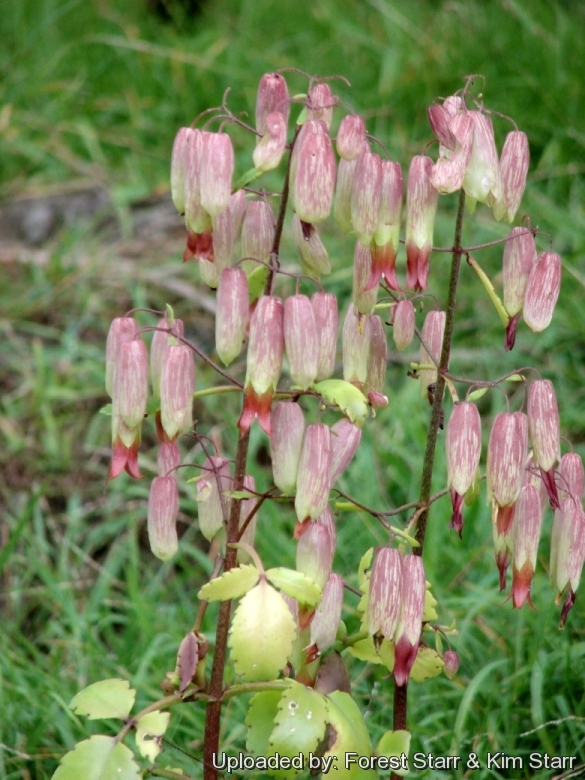
Bryophyllum pinnatum (Kalanchoe pinnata) Photo by: Forest Starr & Kim Starr
Flowers and leaves at Kula, Maui, Hawaii (USA). March 08, 2007.
Origin and Habitat: Tropical Africa, native area probably Indian Ocean Islands (Madagascar). Now pantropical: Africa, Asia, Oceania North America (Mexico and southern Florida), Central and South America, West Indies, Macaronesia, Mascarenes, Galapagos, Melanesia, Polynesia, and Hawaii. Worldwide used as medicinal plant and much planted in gardens, also as ornamental, and often escaping.
Habitat and ecology: Kalanchoe pinnataSN|29116]]SN|29116]] is a common weed in banks, hummocks, waste grounds and thickets in dry and wet regions, ascending to 1400 metres, on foothills and along the slopes especially in the thin layer of soil by exposed rocks. The abundant nectar in the flowers suggests of visits by by sunbirds.
Synonyms:
See all synonyms of Kalanchoe pinnata
back
Accepted name in llifle Database:Kalanchoe pinnata (Lamarck) Pers.Syn. Pl. (Persoon) 1: 446 1805Synonymy: 20
back
Common Names include:
ENGLISH: Life plant, Floppers, Air Plant, Life Plant, Miracle Leaf, Goethe Plant, Cathedral Bells
BENGALI (বাংলা): পাথরকুচি
CHINESE (中文): 落地生根, Luo di shen gen, Wan fei
ESTONIAN (Eesti): Sulgjas kalanhoe
FILIPINO: Kataka-taka, Katakataka
GERMAN (Deutsch): Goethe-Pflanze
HINDI ( हिन्दी): Jakh me hayat, पथरचट्टा, पथरचटा
ILOKANO or ILOKO (Ti Pagsasao nga Iloko): Abistrana, Abisrana
INDONESIAN (Bahasa Indonesia): Suru bebek, Cocor bebek
JAPANESE (日本語): セイロンベンケイ, Seiron-benkei, Sohichi-gusa
JAVANESE (Basa Jawa): Cocor Bèbèk
LATVIAN (Latviešu): Plūksnainā kalanhoja
LITHUANIAN (Lietuvių): Plunksninė kalankė
MALAYALAM (മലയാളം): ഇലമുളച്ചി
ORIYA (ଓଡି଼ଆ): ଅମର ପୋଇ
POLISH ( Polski): Żyworódka pierzasta
QUECHUA (Runasimi / Qhichwa simi): Ch'uqriyuyu
RUSSIAN (Русский): Каланxо́э пе́ристое, Kalanchoe peristoe
SPANISH (Español): Flor de arete, Hoja del aire, Yerba de bruja (Puerto Rico), Bruja (Puerto Rico), Hoja vidriosa, Hoja fresca
TAGALOG: Katakataka
TAMIL (தமிழ்): Malaikkalli, Runakkalli
THAI (ภาษาไทย): คว่ำตายหงายเป็น
TONGAN (Faka-Tonga): Pipivao
UKRAINIAN (Українська): Каланxое пірчасте
VIETNAMESE (Tiếng Việt): Cây thuốc bỏng, Cây sống đời, Cây lá bỏng
Description: Kalanchoe pinnataSN|29116]]SN|29116]] (Bryophyllum pinnatumSN|29120]]SN|29120]]) is a succulent plant distinctive for the profusion of miniature plantlets that form on the margins of its leaves even when the leaves has been detached from the plant, a trait it has in common with the other members of the Bryophyllum section of the Kalanchoe genus. It's not difficult to see why some call this plant “Life Plant” or "Miracle Leaf" because of the small plantlets growing from the fringes of the leaves. The plantlets drop off and root, forming many new plants in a single location. Because of this rapid growth in many areas, they are considered an invasive species. The plant produces bell-shaped blossoms that dangle downward in clusters accounting for the other common name, “Cathedral bells”.
Habit: K. pinnata is a monocarpic perennial succulent herbs, little-branched, almost shrub-like, eventually suckering at base, completely glabrous, green streaked with purple and glaucous.
Stems: Terete, erect or ascending, stout, terete, 0.5–2 m long, 05–20 mm accoross, simple, spotted or striped with red, sometimes with sterile shoots at the base.
Leaves: Dimorphous opposite, decussate, evenly spaced, crowded in young shoots, distant in adult ones. The first leaves are petiolate, simple. Later leaves are imparipinnate, short-stalked 3-foliolate, very occasionally 5-foliolate, sometimes some or all of them reduced to the terminal leaflet. All the leaves elongated-ovate or elliptic-oblong, 5–20 cm long, 2–12 cm wide, fleshy, light green streaked with purple, with broadly crenate, doubly crenate or crenate–dentate margins, apex obtuse, surfaces ± glaucous; bulbils in notches of leaf margins. Leaflets ovate or ovate–oblong to oblong–spathulate, the terminal one the largest, usually contracted at the base or sometimes attenuate into a petiolule. Petiole subterete, 20–100 mm long, greenish with violet blotches, semi–amplexicaul. On distal leaves there are nectaries that at flowering time secrete droplets high in glucose. Older leaves detach easily from the stem and bear adventitious buds.
Fruits (follicles): About 1.5 cm long.
Inflorescences: Cymes panicled, loose, to 10-80 cm wide; branches to 12 cm; bracts foliar. Pedicel nodose, slender, divaricate, 10–25 mm long reflexed at the extremity.
Flowers: 2-3 cm across, pendulous. Calyx-tube lobed above middle, pale yellow to green with reddish blotches, cylindric–tubular, inflated, 25–50 mm, (papery), tube 24–40 mm, lobes deltate to subsemiorbicular, acute 7–10 x 7–11 mm, shorter than tube, apex acute. Corolla tube greenish white longer than the calyx and exserted portion maroon, (20-)30–40(-70) mm long, suburceolate 8-folded, contracted basally, sparsely glandular within, apex reddish, constricted above carpels, and then elongate–tubular–4–angled, lobes oblong-ovate to triangular, 9–20 mm x 4–6 mm, deltate, apex very acuminate. Stamens slightly exserted, inserted above the constriction of the corolla, anthers 2.6–3 x 1.6–2.2 mm, ovate. Hypogynous scales adnate to carpels 1.8–2.6 x 1.4–1.8, subquadrate, obtuse or emarginate at the apex. Styles 22–30 mm long.
Phenology: Flowering winter–spring.
Fruits (Follicles): 12–14 mm long, ovoid, connate at the base for 2.2–3.5 mm, attenuate into the styles.
Seeds: About 0.8 x 0.35 mm, obovoid, obtuse.
Chromosome number: 2n = 36.
Notes: One of its common names, Goethe Plant, was a result of the great interest that Johann Wolfgang von Goethe, a writer and amateur gardener, had in this plant. He raised them and often gave them as gifts to people who visited his home.
Bibliography: Major references and further lectures
1) Forest & Kim Starr “Kalanchoe pinnata (Air plant)”. Plants of Hawaii. <http://www.starrenvironmental.com>. Web. 27 Sep. 2014.
2) Wikipedia contributors. "Bryophyllum pinnatum." Wikipedia, The Free Encyclopedia. Wikipedia, The Free Encyclopedia, 5 Jun. 2014. Web. 20 Oct. 2014.
3) “German Homoeopathic Pharmacopoeia” Volume 2 Medpharm Scientific Publisher, 03/Nov/2003
4) Cram101 Textbook Reviews “Just the fact101 Text Book Key Facts” e-Study Guide for: Plant Biology” by Rost” Cram101 Textbook Reviews, 01/Jan/2013
5) Shane Smith “Greenhouse Gardener's Companion: Growing Food and Flowers in Your Greenhouse Or Sunspace” Fulcrum Publishing, 2000
6) Peter Hanelt, Institute of Plant Genetics and Crop Plant Research, W. Kilian “Mansfeld's Encyclopedia of Agricultural and Horticultural Crops: (Except Ornamentals)” Springer Science & Business Media, 10/Apr/2001
7) K. M. Matthew “An Excursion Flora of Central Tamilnadu, India” CRC Press, 01/Jun/1995
8) Ginger Schmidt “Seeds from My Garden” iUniverse, 01/Aug/2009
9) J. Hutchinson and J. M. Dalziel “Flora of West Tropical Africa” Vol 1 Part 1 Cycadaceae – Guttiferae Crown Agents, 1954
10) R. Fernandes “Flora Zambesiaca” FZ, Vol 7 Part 1, page 3 1983
11) Reid V. Moran “Bryophyllum pinnatum (Lamarck) Oken [family CRASSULACEAE] Flora of North America” Vol 8 Magnoliophyta: Paeoniaceae to Ericaceae. Flora of North America Editorial Committee. 2009.
12) Maire, R. “Flore de l'Afrique du nord” vol. 14. Lechevalier éd., Paris, 1976
13) List Fungi, Fl. Fau. Madeira Selv. Arch.: 191 2008
14) F. Friedmann: "Sur de nouveaux nombres chromosomiques dans le genre Kalanchoë (Crassulacées) à Madagascar." In: Candollea. Band 26, Nr. 1, 1971, S. 103–107
15) Bernard Descoings: "Kalanchoe pinnata." In: Eggli: "Illustrated handbook of succulent plants." Crassulaceae: 2003
16) Freire Fierro, A. 2004. “Crassulaceae.” 73: 4–16. In G. W. Harling & L. Andersson (eds.) Fl. Ecuador. University of Göteborg, Göteborg.
17) Funk, V. A., P. E. Berry, S. Alexander, T. H. Hollowell & C. L. Kelloff. 2007. “Checklist of the Plants of the Guiana Shield (Venezuela: Amazonas, Bolivar, Delta Amacuro; Guyana, Surinam, French Guiana).” Contr. U.S. Natl. Herb. 55: 1–584.
18) Hamet, R. 1908. “Monographie du genre Kalanchoe.” Bull. Herb. Boissier, sér. 2, 8: 17–48.
19) Johann Wolfgang von Goethe: Goethe's sämtliche Werke. Band 6, J. G. Cotta, 1857, S. 161–162 FAZ. 9. Juli 2010, S. 49
20) Tolu Odugbemi “A Textbook of Medicinal Plants from Nigeria” Tolu Odugbemi, 2008
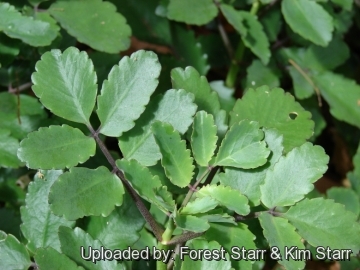 Leaves at Makawao, Maui, Hawaii (USA). March 27, 2008. (Kalanchoe pinnata) Photo by: Forest Starr & Kim Starr
Leaves at Makawao, Maui, Hawaii (USA). March 27, 2008. (Kalanchoe pinnata) Photo by: Forest Starr & Kim Starr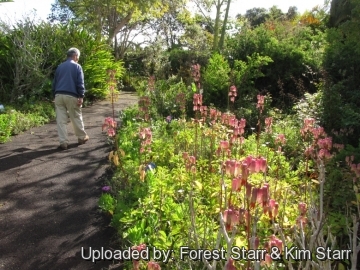 Flowering habit at Enchanting Floral Gardens of Kula, Maui, Hawaii (USA). March 12, 2012. (Kalanchoe pinnata) Photo by: Forest Starr & Kim Starr
Flowering habit at Enchanting Floral Gardens of Kula, Maui, Hawaii (USA). March 12, 2012. (Kalanchoe pinnata) Photo by: Forest Starr & Kim Starr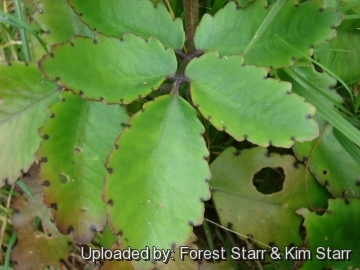 Leaves at Kula, Maui, Hawaii (USA). March 08, 2007. (Kalanchoe pinnata) Photo by: Forest Starr & Kim Starr
Leaves at Kula, Maui, Hawaii (USA). March 08, 2007. (Kalanchoe pinnata) Photo by: Forest Starr & Kim Starr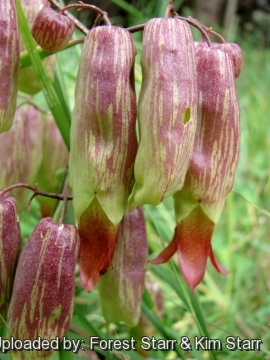 Flowers at Kula, Maui, Hawaii (USA). March 08, 2007. (Kalanchoe pinnata) Photo by: Forest Starr & Kim Starr
Flowers at Kula, Maui, Hawaii (USA). March 08, 2007. (Kalanchoe pinnata) Photo by: Forest Starr & Kim Starr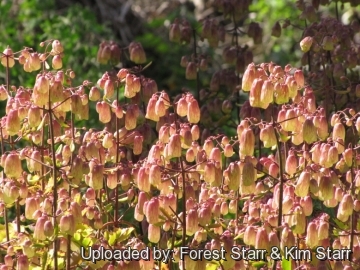 Flowers at Montrose Crater Rd Kula, Maui, Hawaii (USA). March 04, 2013. (Kalanchoe pinnata) Photo by: Forest Starr & Kim Starr
Flowers at Montrose Crater Rd Kula, Maui, Hawaii (USA). March 04, 2013. (Kalanchoe pinnata) Photo by: Forest Starr & Kim Starr Habit in pasture at Kula, Maui, Hawaii (USA). March 08, 2007. (Kalanchoe pinnata) Photo by: Forest Starr & Kim Starr
Habit in pasture at Kula, Maui, Hawaii (USA). March 08, 2007. (Kalanchoe pinnata) Photo by: Forest Starr & Kim Starr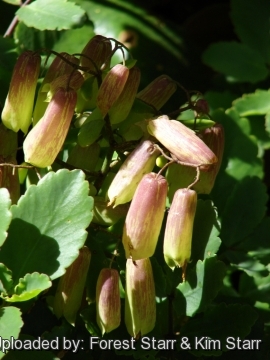 Flowers at Makawao, Maui, Hawaii (USA). March 27, 2008. (Kalanchoe pinnata) Photo by: Forest Starr & Kim Starr
Flowers at Makawao, Maui, Hawaii (USA). March 27, 2008. (Kalanchoe pinnata) Photo by: Forest Starr & Kim StarrSend a photo of this plant.The gallery now contains thousands of pictures, however it is possible to do even more. We are, of course, seeking photos of species not yet shown in the gallery but not only that, we are also looking for better pictures than those already present.
Read More... Cultivation and Propagation: Kalanchoe pinnata is very easy to culture. Architecturally intriguing, these rubbery, extremely handsome plant have become quite popular as an addition to summertime urns as accent plants in recent years. If planted directly in a garden bed, they can easily reach 40 cm and produce large heads of blossoms. It also is used in cactus/succulent or rock gardens. Growing this kalanchoe in a container or pot restricts their growth They are absolutely gorgeous as a cut flower in a tall stemmed green vase. Note that South American air plants have a tendency to spread and leaves that break off can start new plants in adjacent pots. Some similar plants that also produce an abundance of plantlets include Kalanchoe delagoensisSN|14418]]SN|14418]] and Kalancboe daigremontiana. These are fun plants for kids to have and experiment with and provide a good lesson in plant propagation.
Potting mix: They thrive in nutrient poor soils, possibly acidic or neutral, consisting of equal parts of loam and sand, with pumice or lava grit added to ensure good drainage.
Exposure: Mature plants do best in full sun to partial shade. Indoors, it does best in bright light, but not direct sun through a window.
Watering: It needs moderate watering in autumn and spring while in summer it should be watered thoroughly and allowed to dry before watering again. In winter give only occasional watering (only when the plant starts shrivelling), but it will generally grow even in winter if given water. These plants will survive on neglect. Over-watering is the most common cause of plant failure. It can resist also to long drought periods
Frost resistance: The plant can be cultivated in open air only in the zones with tropical, subtropical and, marginally, warm temperate climate and it is hardy to -2° C for short periods but cannot tolerate hard freezes. USDA Zones 9B - 12.
Maintenance: Be careful with this species in outdoor culture, once it gets into a planting bed it is difficult to get rid of it, a few tiny plantlets seem to survive any attempt to weeding them out every time, and then they reproduce again.
Pest and diseases: The plant is subject to attacks of aphids and scale insects, and for this reason is to be periodically controlled in order to effect a quick intervention if necessary.
Uses: Worldwide used as medicinal plant for its antipyretic and anti-inflammatory properties. Much planted in gardens, also as ornamental, and often escaping. In China, India, SE Asia, West India etc. cultivated upon commercial scale. In Thailand locally grown as spice. in Indonesia in rice producing areas for ritual purposes. Rather recently introduced in Cuba as a magic plant. It has been the subject of many physiological and anatomical studies.
Propagation: It reproduces by seed, cutting, easily also by leaf, division or by means of the plantlets which at times grow up at the base of the petiole. Even a single leaf stuck into the soil or potting medium will take root! It grows easily roots at the end of a leaf stalk which has fallen onto ground. New plants are ready within months.
Warning: Parts of Kalanchoe pinnata are poisonous if ingested. All members of kalanchoe are toxic for livestock, birds and small animal, due to the presence of cardio-active glucosides.

















